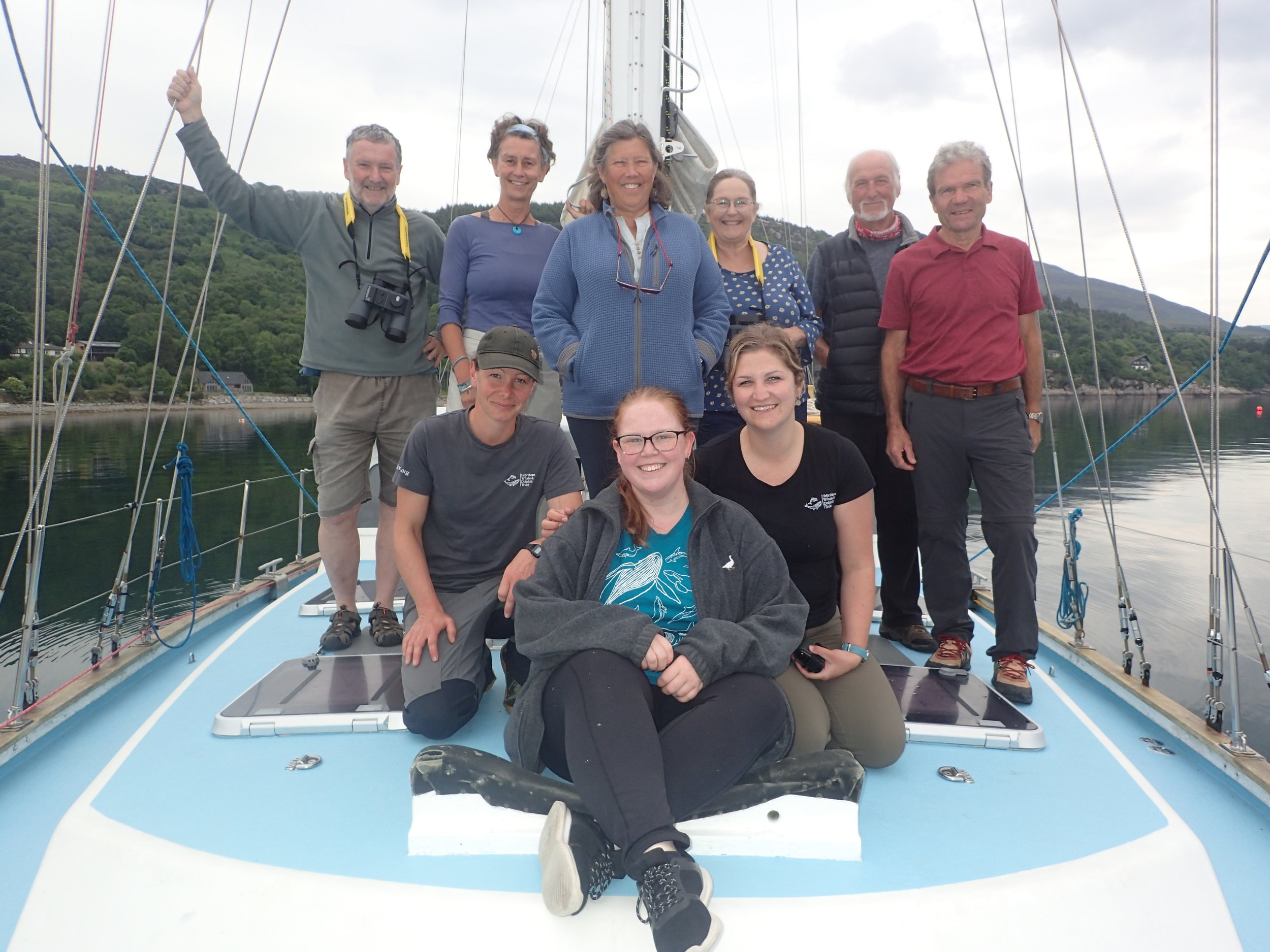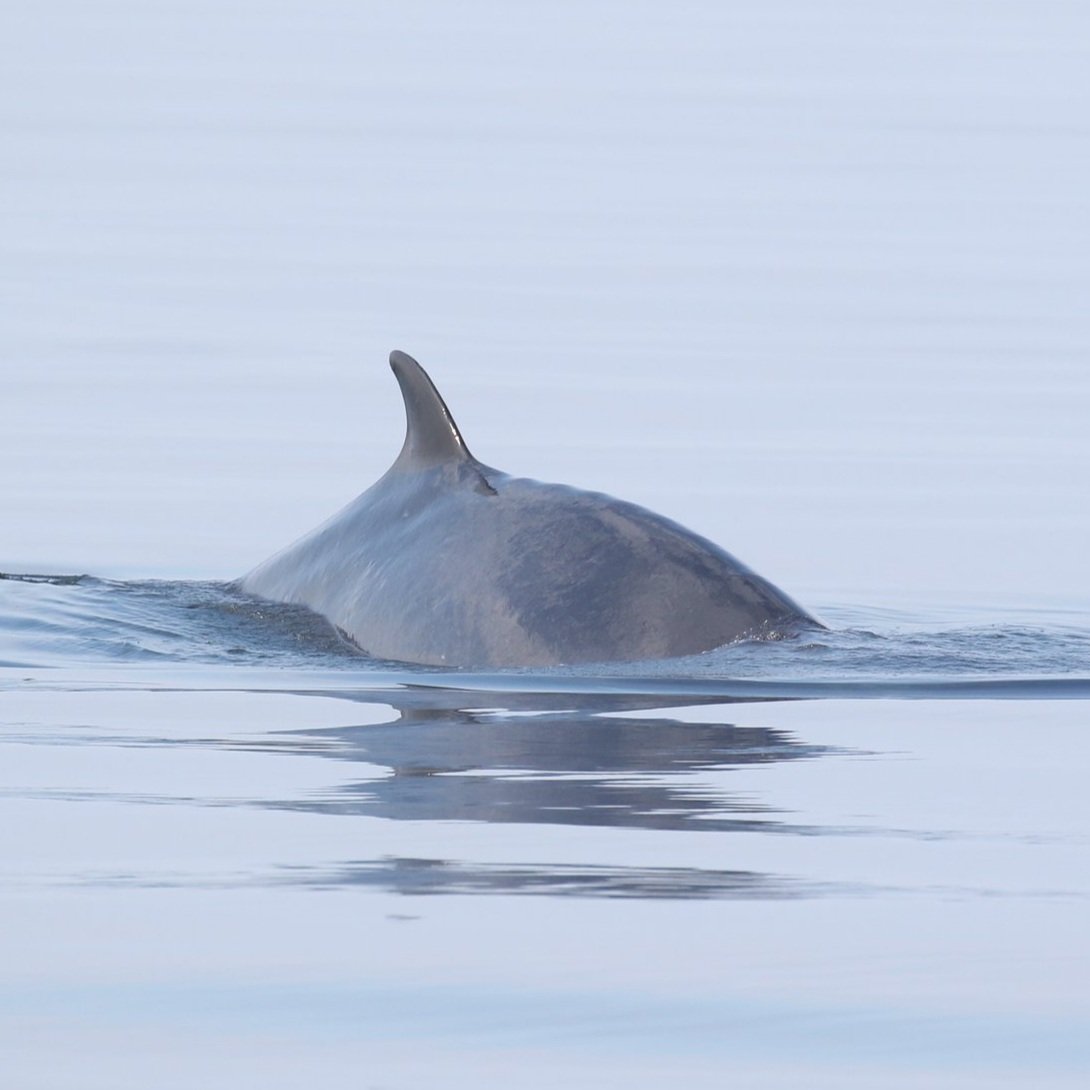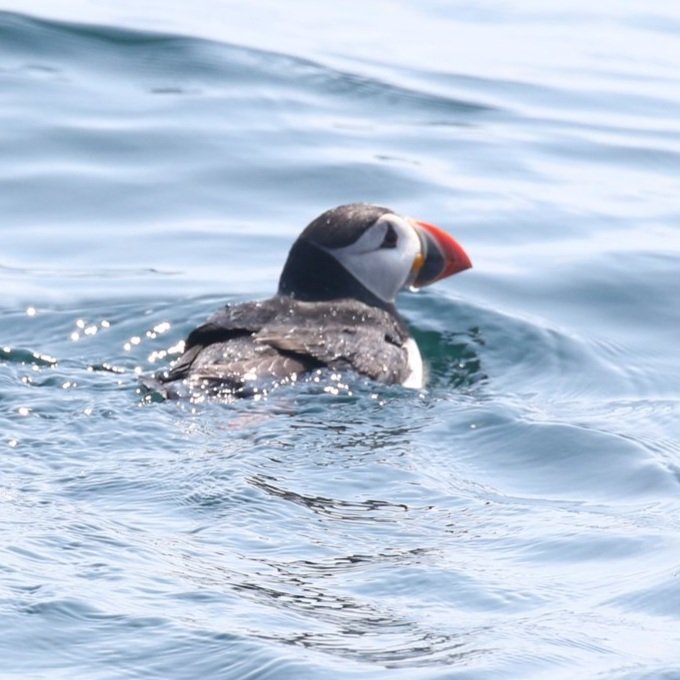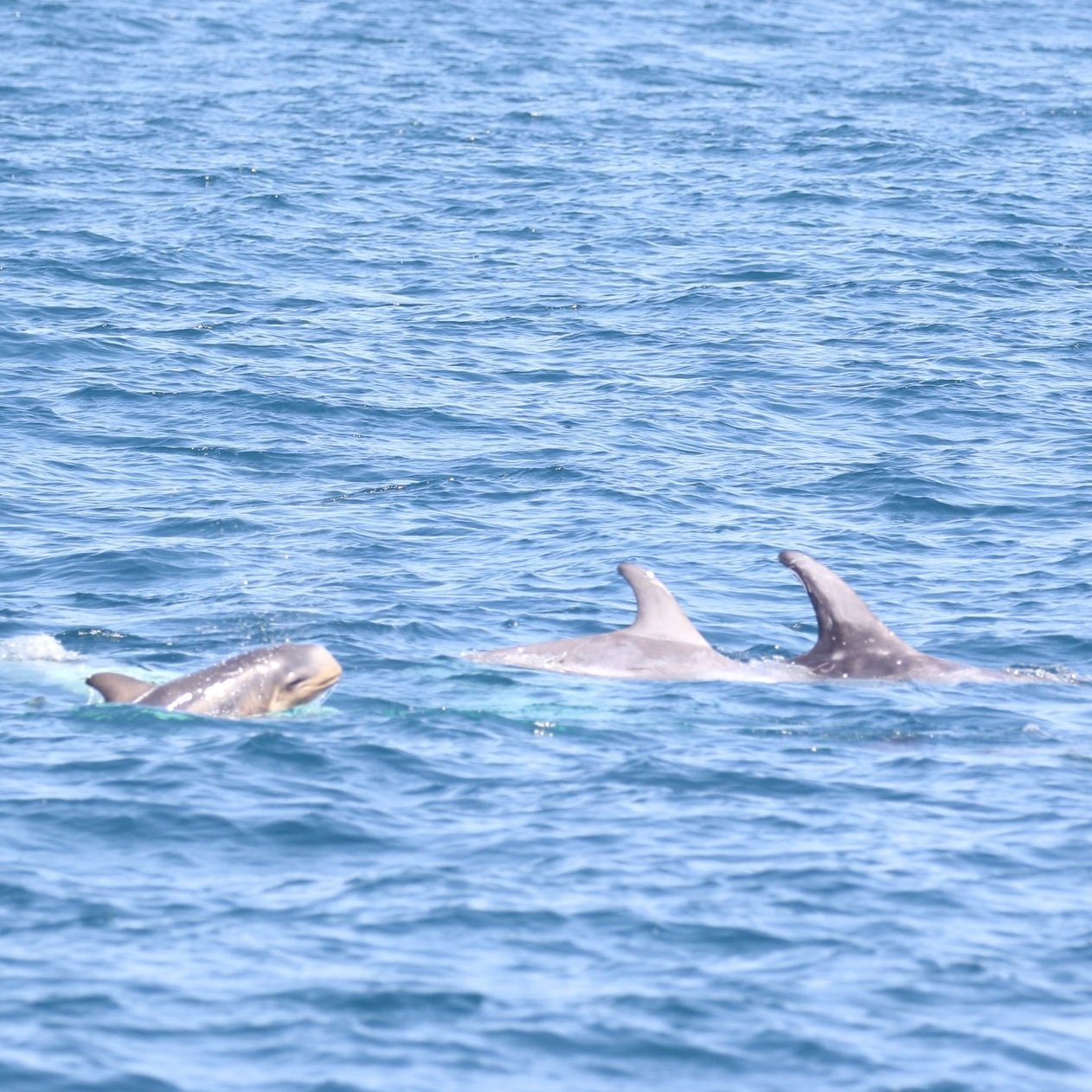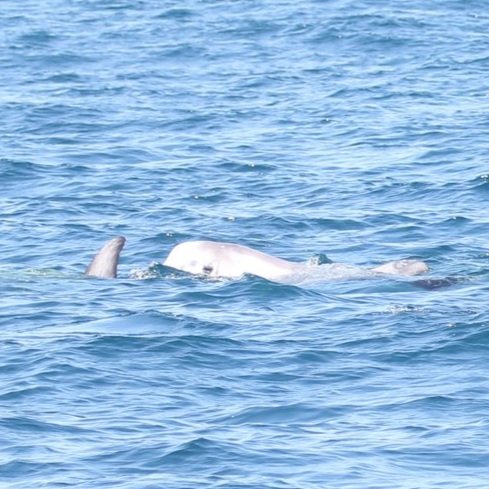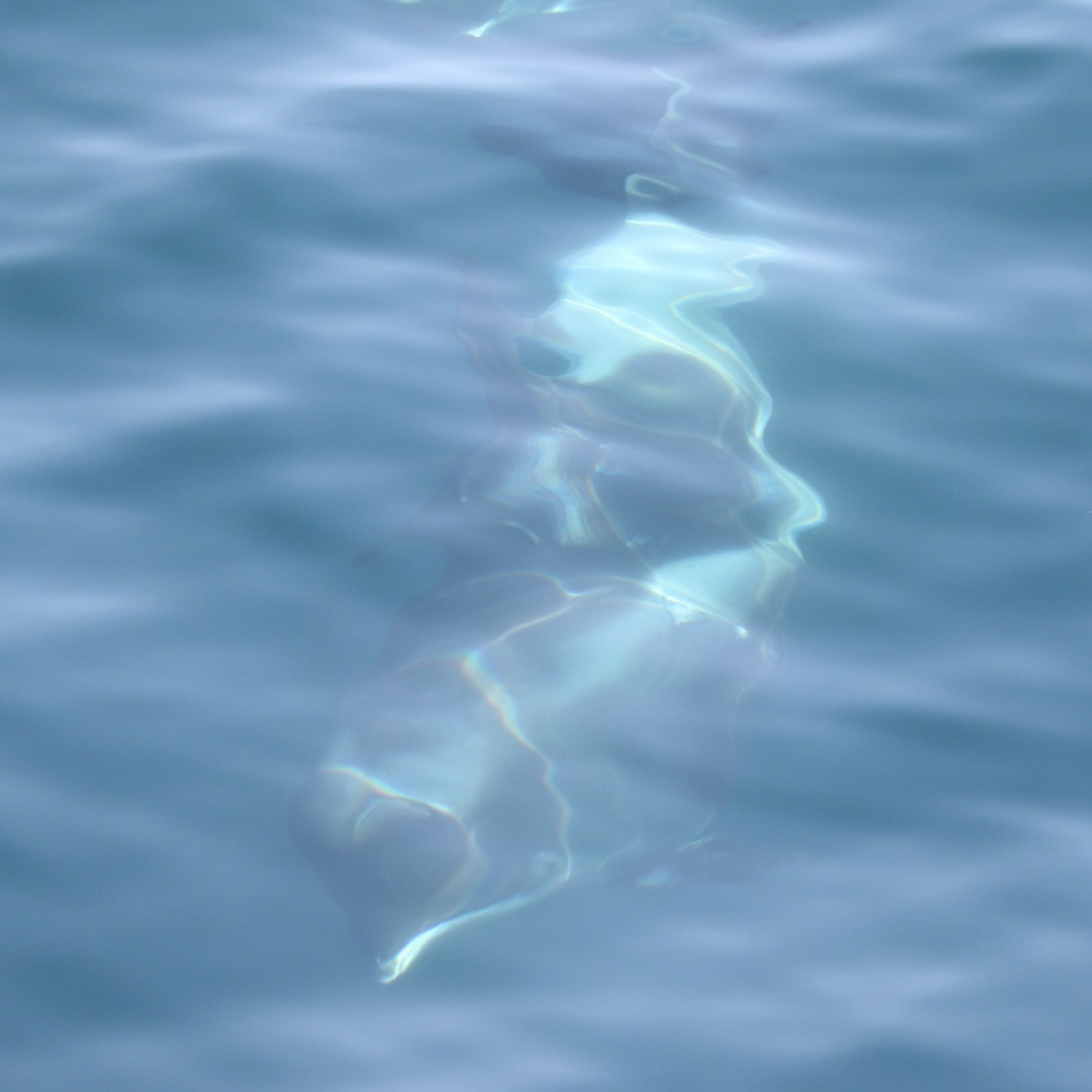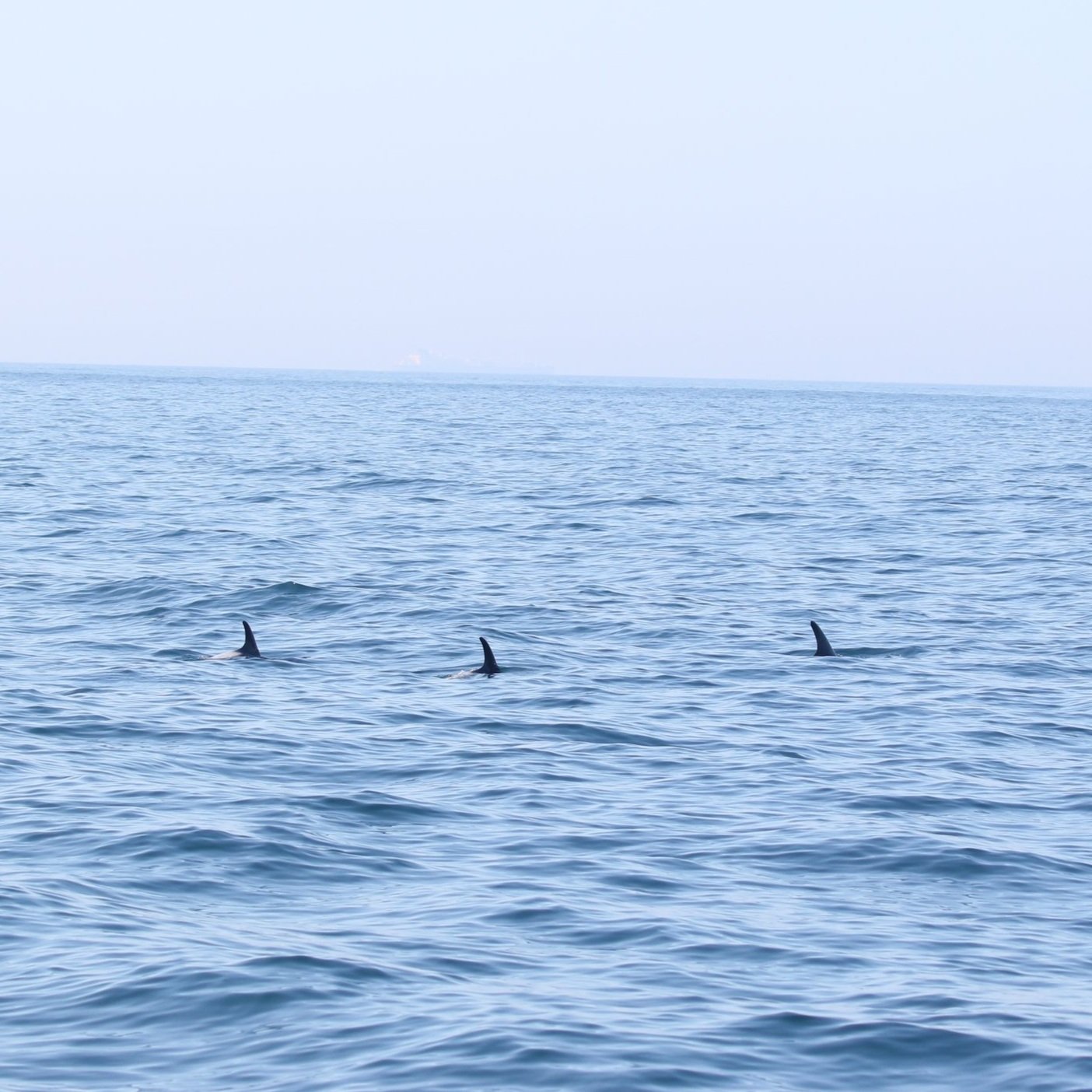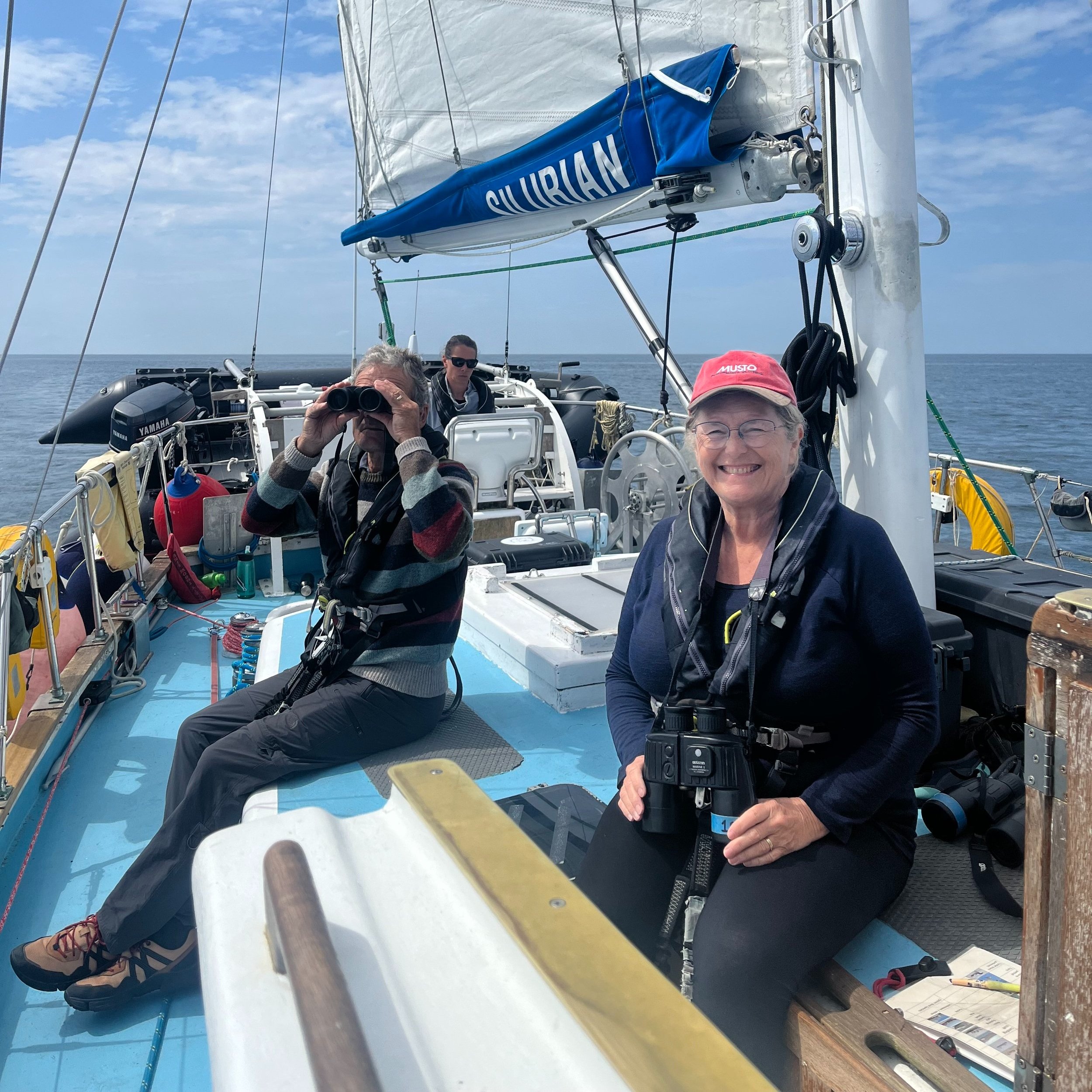Sixth research expedition surveys as far west as the Flannan Isles
THE TEAM JOINING our SIXTH research expedition left ULLAPOOL to monitor the waters off the west coast of scotland. nine SPECIES OF MARINE MAMMAL WERE recorded and the team was treated to remote anchorages and GLORIOUS SUNSHINE. one of the citizen scientists who joined the expeditoin recALLs their experience below…
DAY 1
We arrived in Ullapool where the sun was shining - a good omen for the week ahead! The crew who would lead the expedition - Emma, Jenny, Bruce and Rhiannon - greeted us from the pontoons as we made our way down to Silurian, our home for the next 12 days.
Silurian, our research vessel, and home to the teams who join a research expedition to undertake vital monitoring of Hebridean seas.
DAY 2
We began the day with porridge, banana, maple syrup, coffee and toast and marmalade - always a good start. Following breakfast, Jenny, the Science Officer on board and a wonderful teacher, delivered a training session on the data collection methods and the application of the data gathered. Over the first evening, Jenny had introduced us to the animals we were likely to spot. We also discovered that tooth bearing whales can be aged by the rings on their teeth, like the growth rings on a tree.
The observations started after coffee and biscuits, when undertaking survey it’s referred to as being "on effort". We were all timetabled on to our stations (watching, listening, recoding), which were rotated every half hour. I began the day below deck at the science station, waiting for people to shout down with sightings information: where was it, where was it going, what was it doing, and most importantly of all, what was it? Jenny was rushing around enthusiastically, constantly reassuring us that we were doing a good job. It all started slightly manically with sightings right and left. Harbour porpoises seemed to be our early companions, interspersed with creels reports - innocently and unknowingly hiding hazards below the water.
The day crept forward under very benign weather conditions, with none of the thundery showers predicted. The various monitoring stations were rotated, allowing us to take it in turns to scope through the new binoculars, to yell out sightings of minkes and dolphins - sometimes uncertain in type. When your break came, you realised just how tiring but exhilarating the afternoon had become. It was also an opportunity to relax and chat to Bruce, the First Mate or Emma, the Skipper, who had been busy all day looking after us. Our tally was 25 harbour porpoises, 4 seals, and a grey seal!, 5 minke whales, 24 common dolphins, and various unidentified animals - too distant or too shy to identify themselves. Tea and biscuits brought round by the crew sustained us through all this effort until we saw our target destination: the Shiant Islands appear in the mist and we motored majestically into the safe harbour provided by the encircling little islets. The anchor was dropped carefully into the water, watched by hundreds of circling, pantomimic auks - Razorbills, Guillemots, Puffins - entertaining us with their manic turns, landing, taking off, flying around, only to land again.
A wonderful, hot supper of curried vegetables, dahl and rice was then put on the table by our very caring crew, eager to look after us and reward us for our hard work and we all sat around the table chatting about what we had seen during the day. Roll on tomorrow!
DAY 3
What a morning the Shiants offered us, a cacophony of squawks, screams and yells. we were all following skippers rules that there was to be no conversation until breakfast started at 7.30, so all noise was coming from the very busy auks, plus shags, gulls, bonxies and oyster catchers, even a group of seals were grumbling about having to wake up.
After a quick first breakfast, everyone were shepherded into another learning session. This time, Jenny was to teach us about birds: the different species, their behaviours and how the presence of birds and what they were doing could be indicative of the presence of whales and dolphins. We were then set to record what we’d just learned, but not only that, they had to make a note of all the boats that they had seen too. We were also trained in trying to recognise what vessels were trawling, dredging, fish farms boats, which boats picked up creels, what military boats might look like. Then we could manage the task of identifying and recording boats and all the other different craft on the water.
It was only then that we managed to pull ourselves away from the beautiful anchorage in the heavenly, sun dappled, but mist cloaked Shiant Isles - I do really want to return there and experience the most wonderful, noisy, but also peaceful morning. And there was a second sense of regret, a promised sighting of a white tailed eagle didn't occur, the crew were devastated.
We did eventually pull ourselves away, motored out of the shelter of Garbh Eilean, crept round the headland to see the rock arches before heading out on our observations. We headed north east into the Minch, approaching East Bank, then north towards Tiumpan Head. Some hours were spent motoring, going through our various research roles, spotting as we went. You might imagine our delight when members or the crew turned up with our "second" breakfast: a choice between Emma 's rolls filled with deliciously cooked egg mixture (the Skipper's speciality) or bacon. The morning was incredibly still with very little disturbing the surface of the sea but it was a little misty, restricting the visibility even though it was a beautifully bright day. Hebridean Seas were apparently rarely like this, but we found that very difficult to believe and are all convinced that the area is next to heaven permanently. During this period we saw various individuals and small groups of harbour porpoises - recording a total of nearly 20. There were also a few seals and various unidentified sightings. We counted 9 minke whales although failed to get photos of any of the creatures who managed to tease us by appearing at distance but rarely coming close. This sort of cat and mouse game continued until mid afternoon when for a wonderful fifteen to twenty minutes we were surrounded by a huge number of common dolphins. The audio listening picked up all sorts of squeaks and clicks sent out by excited dolphins, who followed the boat, leaping out of the water, riding the bow wave. The small group that initially joined us were so excited that they called on mates from all across the Minch to come and have fun. Every time we looked up in another direction, we could see small groups rushing over to join us. Jenny estimated around 400 dolphins in total. It was certainly one of the most exciting and memorable experiences of the trip so far.
But how to top that, well, a detour into Stornoway to refuel meant that we could have a nice shower in the marina, followed by an ice cream, back to the boat for a very gently motor in the evening sunshine, down to our anchorage in Loch Liurboist. We all enjoyed a delicious supper prepared by Jackie and Roger, before some evening entertainment playing pass the pigs.
Common dolphins delighted everyone on board during the third day of survey
DAY 4
A misty morning sky started our day, our skipper Emma had given special permission to have a later breakfast - “stay in bed until 08.00, and the "no talking rule" now lasted a further 30 minutes”. It was explained that the reason for this very generous offer was down to the fact that the water was moving in the wrong direction and we had to wait until it was doing the right thing. The wonderful world of tides…and we thought that the tide only went in to a sandy beach and out again. But now we hear that the water also moves up and down the coast line, it goes round and round the islands. But Emma understands the tides, and put us on the right track. We motored down the eastern side of Lewis, into Harris - which forms part of the same island that was quite confusing for some on board. It seems strange that an island has two separate names, but I am sure that there’s a very simple explanation for this. Perhaps based on which grumpy warlord, no sorry, clan chieftain, held sway at the time and wanted to name part of the island after themselves?
After the pleasure of an extra half our of monastic silence to start the day, we were then told that we had an extremely long day ahead of us, meaning that being "on effort" was likely to last all day and all night (well, given that it hardly ever gets dark in north Scotland over mid-summer, we could believe that it would be "all night").
The water wasn't as flat and comfortable as it had been on the previous day, nor was the visibility so good. The number of sightings seemed more limited, but we continued to clock up bird sightings and the occasional harbour porpoise and seal. The real excitement started in the afternoon: the sun had broken though, crew members were removing warm clothing layers, most of the mist had cleared and almost exactly 24 hours after the invasion of the common dolphins, it was time for more dolphins. At first we thought it was Jenny telling us about dinner, and she was so excited in her normal Tigger-like way....."rissoles" I thought she’d said. But no, the flat faced dolphin that we saw jumping leisurely out of the water is in fact known as a Risso’s dolphin. Apparently, it is of the genus "grampus" which may even be a reference to its rather dour expression. Jenny apparently adores them, so we were delighted for her to be able to see at least five of the creatures bouncing across the sea, clearly ignoring her attempts to photograph them from the bow of our boat.
Well, after all the excitement of the grampus meeting, we continued to motor on through the Sound of Harris. Our observations seemed to report on regular shouts of creels, before eventually Jenny's drumming signalled completion of our "on effort" for the day, after something like eight and a half hours. It seemed like for ever, but everything turned out for the best as we motored into Loch n h"Uidhe - a beautiful little bay off the little island of Taransay, just west of south Harris. "Who wants a swim" said captain Emma, and much to our surprise, four people said "yes" even though it was gone eight o'clock and we were on the west coast of the Outer Hebrides. Others went ashore and walked but the four dipped bravely into the cold evening Atlantic water, claiming, of course, that it was lovely and warm. Back to Silurian in the tender, and time for dinner, courtesy of Yotam Otalengi, Sarah had turned out a lovely dish of potatoes pie with sausages, a lovely way to end the evening.
DAY 5
Breakfast was back to 7.30am, as an earlier finish was planned to allow us time to relax. During the meal, Emma's unfair christening as Eeyore was thrown into question as she started to get excited about the location that were aiming for at the days end. Eeyore had been adopted because every time a suggestion was made about a wonderful animal or bird that was likely to be seen, Emma would interject with a warning about not wanting to raise expectations. The aforementioned Jenny (otherwise known as Tigger) had been in trouble a number of times for over-enthusiasm when describing things to be visited or seen. But clearly Eeyore had been seeing audience reaction to Tigger, and keen to get audience support, tried an enthusiastic description of our target for the night's anchorage.
We were told that the destination, after surveying for few hours was to be the Monach Islands, which Eeyore had visited before but Tigger had never been to and a place that Eeyore described as "really cool".
The observations of the morning started slowly, excitement was raised by hoisting the sails, but there was only enough wind to motor-sail. Discussions drifted into whether the whales and dolphins had all gone to sleep , a theme that entertained us for a while. The wonderful weather kept us going, but things collapsed rather when Sarah, lying on the foredeck absorbing the sun, spotted a cloud that was not unlike a minke whale, or at least she tried to convince us of that fact. A flying whale, a very new addition to HWDT scientific data, very useful in the work to influence Scottish policy makers. It was at this point that our esteemed scientific officer became less Tigger like and more influenced by Captain Eeyore, she rushed up to the foredeck and reminded us that our real task was to observe for cetaceans in the sea, and that to the best of her knowledge, none of our target species could actually fly.
Jenny commiserated in the lack of success at observing the right sort of animals and pointed out that acoustics had also returned little detections today. However, ‘no data’ is still valuable data!
And then, after spotting numerous puffins and other auks in smaller numbers, the moment of truth arrived, after nearly four hours of scanning the seas, the first shout came, "...sighting...", ....ooh....who was that.... oh...., it was me! Everyone rushed up on deck as the suspicion was that it was a minke, but nothing further. Clearly this whale didn't know the rule that it was supposed to surface three times. We went off transect to look for the blighter and I was definitely beginning to doubt my abilities as an observer when fortunately Bruce, the first mate, confirmed that he had also seen the beastie. But sadly no further contact was made to confirm the species or take photographs to attempt to identify.
The afternoon continued in the same fashion with rotations continuing but nothing by way of observations.
We arrived early in the anchorage on the Monach Isles...... absolutely beautiful. Eeyore was so right to be excited. Again the RIB was lowered, and all bar the skipper went ashore, some to swim, others to walk. Doom, or it felt a bit like it, was broadcast before we went ashore, about the dangers offered by some pretty muscle bound and testosterone filled male grey seals found in a colony ashore., Some recent seal behaviours had given cause for safety concerns. Well cautioned, we went ashore and carefully entered the water with lookouts stationed. Possible good fortune that the water was so cold, but none of us lingered long , and no seal was disturbed by or involved in our swims.
One party was returned to the mother boat in the RIB, and as this happened, the waiting beach party claimed another sighting. The frustration of watching the scene develop around the Silurian was almost too much to bear, bottlenose dolphins, two pairs of adults, each with a youngster, swam round and round the boat, swam underneath and almost over the top. Jenny on the beach could not control herself, willing Bruce's return with the RIB to pick us up.
When he did (at last) return, our reward for our patience was more than gold could provide. The dolphins approached the RIB, swimming carefully around and underneath us, braking the surface only feet away from our little boat, and apparently shepherding us back to the safety of Silurian. Sadly, but possibly understandably, when we clambered aboard, the dolphins swam round us again, once or twice, before, job done, they swam off across the bay for other adventures.
After celebrating with a cold bottle of Cava, we indulged in lovely curry supper prepared by Jen and Bill, followed by Tai Chi led by Bill on the foredeck and plenty of chatting as the sun set beautifully behind the ruined croft at the western end of Ceann Iar.
DAY 6
We woke to a beautiful morning at the Monach Isles, lying to the west of North Uist, accompanied by the grumbling and trumpeting of grey seals in the colony on the other side of Sibhinis, the little island in whose lee we were anchored.
We set off after our traditional first breakfast, overnight porridge oats with a variety of trimmings added by skipper Emma, including turmeric - added to for colour, taste, health inducing properties - fantastic. We started to motor our way from the anchorage to start our transect, just to the north of the islands. At 12.15, I noted that after three and a quarter hours "on effort", we had managed one sighting of a seal and one dolphin! But we had seen many, many, many creels, buoys marking the end of lines of baskets dropped to the bottom by local fishermen to catch prawns, langoustines, lobsters and crabs. It was hot, but we were drinking lots water, and gradually, as the day went on, sweaters were removed, then shorts donned - it was fantastic weather, is this really the Outer Hebrides? As we motored north, out into the Atlantic, it was very calm but a gentle swell kept us on our toes.
The day was unexciting in terms of sightings, but it gave me time to reflect on how it was, standing at the mast on observation, staring into the distant sea, using binoculars, eyes getting tired, transferring sunglasses to face, feeling really bored but sustained by a kind of excitement that you were, any second, about to see an black back, arched out of the water with identifiable fins to allow you to call back in the boat that you had a sighting. I'm like a coiled spring, ready to explode into action! Then you realise you're a king, three quarters of an hour on the mast, constantly peering, and then wow, you've seen something, "sighting" you yell back to the relay station, before having to decide, bearing, distance, direction of travel, and the species, what they were doing etc.
Back to watching, then the engine pauses for a minute to allow audio analysis to proceed. This is the second pause, and you know that in five minutes, you have an opportunity for a break. You crouch by the mast, leaning hard against it to steady yourself against the rolling progress of the boat, binoculars pressed hard against your face, the final few scans of the horizon.
Then on break.....oh so good, those aching limbs, rest, sitting maybe on deck chatting to the helm, perhaps in the cabin, trying to keep cool (at least today) or maybe in less clement conditions, to keep warm! Eyes aching, slowly allowing the lids to cover my tired eyes and relax.
Next stop on the rotation, the relay station. I must remember to look for the birds, as well as chatting, oh and boats as well, and more chatting and of course, the most important, nearly forgot, relaying the information from the watchers on the mast, to the science station. Puffins galore, sometimes flapping their wings, sometimes diving, sometimes jumping up and running along the water in their fantastic take-off pose. As we approach, they look around with that appearance of absolute panic, what am I going to do, how do I get out of this, and then they're gone, under the water for a dive and calmly swim away from danger.
But the last of today's excitement was to happen, in the last minutes of the day's activities as we approached Kearstay anchorage of the northern end of Scarp. Skipper had eschewed the opportunity to stay in Hushinish Bay to protect us from the southerly swell. A group of white beaked dolphins surrounded us for a while, swimming under Silurian, rolling upside down as they surfaced, providing great excitement for our group who had been starved of many sightings during the day, showing off their white tummies and back patches. And when we finally turned the corner into Kearstay, wow, what a fantastic anchorage and off we trooped ashore for a swim, and beach experience to beat all others…until tomorrow.
DAY 7
This is going to be a good day, happy birthday Roger. And Jenny really pulled out stops with pancakes for breakfast. Sun beating down again (we now know that this is normal Hebridean weather). Roger and Jackie woke to the call of an insistent cuckoo, well they said it was a cuckoo, but bird song is very difficult to distinguish for non-experts isn't it, so we concluded that they must be birders, and highly skilled in recognition.
Leaving Kearstay, in the shelter of Scarp, we moved westwards into the Atlantic. Skipper had promised us fog and we spent all day searching for it, but sadly apart from a very special moment, we were disappointed not to find it all day. Many a creel was called as we left the shelter of the western side of Lewis. Jenny spotted a dolphin, and with her normal verve and energy, and scientific discipline, finally decided that it was a "bog standard" dolphin with the feeble excuse that it was "a long, long way away".
We were on course for the Flannan Isles. This group of rocky outcrops houses a lovely looking lighthouse, built in 1899, by one of a long line of lighthouse builders, David Stevenson, related to Robert Louis. The island also has a secret, the disappearance, a year after it's construction, of three lighthouse keepers in mysterious circumstances, an unsolved mystery with many theories surrounding it. As we approached mist hung below the lighthouse perched on the summit of Eilean Mor, making it seem as though we were on course for something heavenly, with the bright sun illuminating all about the surface of the mist. As we approached, we were generously given time off duty from our observations to watch the thousands of birds around the islands, and we motored on to Roareim, a little island adopted by local gannets as their place of residence, A spectacular number of these birds wheeled, dived, cawed, or simply rested on the rocks, all looking very much at home.
We turned our way eastward to navigate towards our planned anchorage at Loch Roag, in the shelter of Pabay Mor. The way looked great, sun on our backs, the breeze freshening from the north enabled us to get the foresail out and throttle back slightly on the engine, saving fuel and feeling that the rumbling noise was slightly less insistent. In fairly short time, Jen yelled and spotted a group of Risso’s dolphins, although they weren’t too interested in us and didn’t hang about.
Later Jen, once again, managed to get gold stars by finding for us a group of white-beaked dolphins, two family pairs with youngsters, which joined us for a while to much excitement amongst the whole crew. The Tigger behaviours caught up with Jen, who soon after this was seen at the mast, fist pumping, presumably with pleasure at having spotted not one, but two species.
A lovely arrival into Loch Roag, scattered with little islets and rocky outcrops, backed by hills rising into the centre of Lewis, with anchor dropped as we completed the day's work only to get on with our sub tasks of sweeping, cleaning, polishing and most importantly making tea for the skipper, mate and scientific officer! Tea accompanied by the most delicious Welsh cakes, courtesy of Jen.
Some of us went over to a little bay for a very cold swim, but glorious recovery laying on sun heated rocks before returning in our RIB to enjoy bubbles and a lovely dinner to celebrate with the birthday boy. Skippers guidance for the next day suggested an early start to ensure we could round the Butt of Lewis.
DAY 8
What a great morning, crew were clonking about just after 5am. I was aware of the boat starting to move after the anchor was hauled, sometime before 6am. I started buzzing about getting up, but my aching limbs wanted a little more horizontal, so yours truly snuggled down, until feelings of repressed excitement about what I was missing got the better of me and I tumbled out of bed at 6.15am. I dressed speedily and arrived on deck to see what remained of a great sunrise, showing multitudes of little islands as we headed north east along the beautiful west coast of Lewis, hardly a breath of wind, another glassy sea and barely a swell to interrupt the boats passage. We passed a headland called Tiumpen, and it was remarked that on the east coast of Lewis, there is Tiumpen Head, which is not to be confused.
Our day continued with the forecast at the Butt of Lewis being for strengthening easterly winds. We had the tide with us and made good time. Skipper followed the rules and gave the Butt of Lewis headland a wide berth to avoid gathering currents on a turning tide. It did however get very lumpy, the swell coming down from the north growing to one and a half metres with a short chop giving a rather lumpy, rolly experience, but the crew managed to smile and get through.
We turned south after rounding the Butt, still rolling when Bill and Emma yelled in delight at the sight of a big splash in the distance. The idea was picked up by Jen, who was supposed to be watching birds, but so anxious to keep her hits of sightings and win the golden whale award of expedition six of Silurian’s 2023 field season, identified a breaching minke whale. Not to be outdone, our watchers on the mast clocked the animal and swore that they had seen two or three minkes breaching out of the water in a most unusual way that even our educated and experienced scientist said she had never ever seen that sort of behaviour before. Meanwhile, your dozy author was doing guess what, dozing again, but his conclusion is that all this breaching was simply made up as a way of inducing embarrassment for his singularly unproductive behaviour (although, at the time, it has to be stressed, he was on a break session and had been up sailing for over nine hours.
Before we knew it, the drums to indicate end of "on effort" were beating soundly. A slightly earlier end, but skipper had seen the forecast (lightning threats) and spotted the approaching clouds moving westwards from the mainland. Always concerned that we keep safe, she wanted us to get away from the mast and other metallic objects of great interest to lightning, she invited, no, ordered us below decks into the cabin. We sat watching drops of rain fall all around her, feeling sorry as she gathered all sorts of accoutrements to try to keep dry while we sat in a lovely warm and dry cabin eating a fantastic cheese board spread delivered by the ever wonderful Jenny. We were incredibly grateful as she and and then poor Bruce braved the storm and brought us safely into our anchorage at Loch Grimshader, a place sounding an awful lot more fearsome than it turned out to be, surrounded by rolling green hills strewn with rocks and with scattering of human habitation along the shores. A wonderful dinner of haggis, tatties and neeps followed, prepared by master chef and boats first mate, Bruce, with the even more welcome, "a late start tomorrow, we'll give you a bit of a lie in!!!"
DAY 9
We edged out of the claws of Loch Grimshader into very calm Minch, travelling east towards the mainland. We were floating on a blue carpet reflecting a blue ceiling above with little puffs of cloud hanging above the distant horizon where, if you strained your eyes, revealing themselves slowly were the hills of north west Scotland looming towards us out of the distant haze.
Motoring along on watch, motor-sailing again, Sarah suddenly yelled with delight at seeing a group of gannets involving themselves in a feeding frenzy. Frenzy seemed a strange word to apply to the noble art of feeding, but when you watch these birds suddenly spot some poor little fish swimming beneath them they decide to dive elegantly, arrow like, vertically downwards into the ocean and disappear under the water with a little splash. They collect their meal, resurface and then sit smugly on the surface digesting their meal. Groups of ten, maybe twenty all flying dart-like toward the surface of the sea, so one can conclude that it is something of a frenzy as each gannet is anxious to hit the water first and collect the tastiest morsel, before it's mates get there.
It had been mentioned that feeding frenzies were often indicators of whales feeding, but sadly we could see nothing linked to these happenings, but a little later, we spotted a group of common dolphins, admittedly a little way off - some 750 estimated meters but leaping clear of the Minch, their arched backs glistening in the sunlight. The day wasn't long as we motored into Loch Inver to find our mooring in Lochinver, a pretty village nestling at the end of the loch. Coming alongside a pontoon was a very welcome change to anchoring. It presents the opportunity to stroll through the woods to a nearby beach for a gentle swim, and even better to find our way to the fishermen's shower (only one shower, but very clean with plenty of hot water) and wash away the layers of salt coating and sun cream which had been a very necessary covering each day.
DAY 10
We motored out of Loch Inver this morning under very grey, leaden skies after a night of rain drumming steadily on the cabin roof. The forecast was for heavy rain showers, thunder and lightening, and winds increasing form the south east, possibly force six. We dressed ourselves in the waterproof clothes that had been thoughtfully provided by the Whale and Dolphin Trust, with our wellies hiding underneath, to face life "on effort" during our penultimate day of our adventure. Today was marked by an exciting competition to see how many creels could be called to confuse both the relay volunteer sitting at the cabin door and the person entering data into the computer sitting down in the cabin.
The morning and early afternoon had been largely uneventful, with occasional sightings getting our team excited. We sailed south westerly out into the Minch and then turned south east back towards the Summer Isles. There were many groups of razorbills and guillemots but not a huge number of other birds, they obviously don't like the weather. Just after midday, the sky was getting brighter over the mainland mountains, welcoming us back to mainland Scotland a saying farewell to the islands. Over lunch we started to coast our way through the very pretty Summer Isles, turned down towards Priest Island then into the mouth of Loch Broom, and later into Loch Kanaird rounding Isle Martin to our anchorage.
It was as we turned into Loch Broom that the excitement of creels started. Yours truly was on the computer when his colleagues decided to call creel after creel to try to keep him on his toes. So active did he become that when a change of duty occurred, he received a round of applause at his achievement. Expecting the excitement to be over, he moved to the mast and managed to get his own back on his colleagues by calling even more creels. A total of 116 were recorded by Jenny, a very impressive haul!!!!
DAY 11
The last day of sailing and watching "on effort". We awoke to a beautiful morning next to Isle Martin, sunlight picking out the high rocks and ridges of the mountains. Greening the hills and throwing shadows behind the bands of trees growing freshly on the hillsides.
Tea and porridge arrived on the table for breakfast, followed by toast and jam, marmalade, marmite and loads of other opportunities. The disappointing message came through that no second breakfast would be available, however, Emma saved the day by producing a most wonderful first lunch, slightly earlier which made the whole group even happier than if the normal two breakies and lunch had happened.
Motor sailing around the summer Isles followed with plenty of creels, occasional seals and slightly more harbour porpoises. Sun shone all morning and made us feel again, just how lucky we had been with the weather, the location, the company, but especially the wonderful crew. A final meal was consumed ashore in Ullapool, very pleasant but mixed with sad feelings that the next day meant journeys home and disappearance of newly acquired friends.
Goodbye Silurian, thanks for looking after us, and keep up your good work in just trying to help us understand more fully our friends and neighbours in the cetacean family.
Across 12 days, the group surveyed 680 km of Hebridean waters encountering 9 different species of marine animals.

